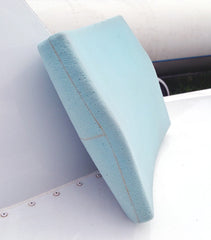- General Info
- About Us
- Articles/Blog
- Distributors
- Contact
Aircraft Seating Applications
SunMate® and Pudgee® viscoelastic foams were developed in the early 1970s by aeronautical engineer Charles Yost, following extensive research for NASA into ways to improve Human Survival in Aircraft Emergencies. Among his findings, Yost determined that an advanced seat design would utilise high energy dissipation cushions and an impact absorbing back structure.
Mr. Yost began experimenting with foam formulations in his home garage in 1968, and soon developed a material he called "Temper" foam -- the first iteration of the materials we continue to make today.
SunMate is used in aircraft seating for its:
- absorption and dissipation of impact forces
- absorption and dissipation of vibration energy
- slow rebound following impact for improved safety and comfort
- full range of support pressures to accommodate any body weight, comfort preference, or structural support need
- equal weight distribution across the seating surface to reduce pressure points
- ability to maintain properties in a greater temperature range (-20°F to 150°F)
- durability and fire safety (FRG)
SunMate FRG passes FAR 25.853(a)
Military Aircraft: Ejection Seating
 Vertical tests performed at the Biodynamics and Acceleration Branch of the Air Force Research Lab at Wright-Patterson AFB demonstrated that a 2" SunMate composite cushion (1" Medium over 1" Medium-firm) transmitted the least energy to the pilot in the catapult stage compared to the 4 other cushion designs configured with some of the current market's top impact-energy absorbing materials. The SunMate composite was designed to optimize long-term sitting comfort in addition to providing necessary impact protection.
Vertical tests performed at the Biodynamics and Acceleration Branch of the Air Force Research Lab at Wright-Patterson AFB demonstrated that a 2" SunMate composite cushion (1" Medium over 1" Medium-firm) transmitted the least energy to the pilot in the catapult stage compared to the 4 other cushion designs configured with some of the current market's top impact-energy absorbing materials. The SunMate composite was designed to optimize long-term sitting comfort in addition to providing necessary impact protection.
Military Aircraft: Helicopter Seating

Slow-recovery, rate-dependent viscoelastic foam used in aircraft seating can reduce and even prevent injury upon impact. SunMate, although light and soft, has an impact energy absorption rating of 12 ft-lb/in3. The rate at which impact energy is released or dissipated can actually increase the acceleration transmitted to the body, so choosing the right material is critical to seat design. A study conducted for the U.S. Army Aviation and Troop Command for their Helicopter Crewseat Cushion Program determined that:
“SunMate foam cushions performed better than the baseline existing cushion on both the dynamic drop tests and the Army-conducted comfort evaluation. SunMate was selected for the final design since it performed much better than the [other] foam in the durability tests and slightly better on most instrumented measurements on the dynamic crash tests."
Gliders & Light Aircraft Seating
In January 2014, Sailplane & Gliding magazine featured an article by Dr. Tony Segal on the effectiveness of energy-absorbing safety cushions used in gliders. The article summarized testing he performed at the Defence Research Agency Center for Human Sciences in England. He evaluated 3 different energy-absorbing materials, including SunMate (branded as Dynafoam in the UK). The tests determined that firm SunMate:
- significantly reduced lumbar spinal loads under high-velocity impact
- material structure remained intact under rapid decompression in the altitude chamber
- proved effective in both warm and cold temperature testing
- held-up after 4 years of heavy use with only slightly less load reduction than a new cushion
- could achieve sufficient comfort with a top layer of 1/2" thick soft SunMate without sacrificing spinal protection.


 “I wanted to drop a line to give you some feedback on the new seats — They're great bar none! The Kiowa Warrior is the only aircraft I have flown since flight school, and the seats you all have developed and provided to the Kiowa Community are hands down the best I have sat my tail on in over 2200 flight hours. Currently we have half our fleet with the new seats and my aviators all fight for the aircraft that have the new seats.”
“I wanted to drop a line to give you some feedback on the new seats — They're great bar none! The Kiowa Warrior is the only aircraft I have flown since flight school, and the seats you all have developed and provided to the Kiowa Community are hands down the best I have sat my tail on in over 2200 flight hours. Currently we have half our fleet with the new seats and my aviators all fight for the aircraft that have the new seats.” "In five weeks of solo flight, I have used the cushion in the Discus and the ASW 27. It is perfectly comfortable and I am sure it would help protect the lower spine from impact in case of a hard landing or accident." [paraphrased from translation] - Dr. S. Zlot, Bern, Switzerland
"In five weeks of solo flight, I have used the cushion in the Discus and the ASW 27. It is perfectly comfortable and I am sure it would help protect the lower spine from impact in case of a hard landing or accident." [paraphrased from translation] - Dr. S. Zlot, Bern, Switzerland

